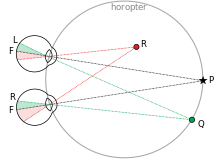Interocular transfer
[1][2] IOT can occur in various tasks involving motion aftereffects (MAE), depth perception (stereopsis) and visual learning.
Most of the early research in interocular transfer introduces the role of binocular neurons in the process of interocular transfer,[4] the role of adaptation in the IOT process occurring in motion aftereffects (MAE),[5] and use of IOT in determining the stereoscopic vision in those with visual disorders like amblyopia (lazy eye syndrome) and strabismus.
[6] The groundwork for interocular transfer research began after Hubel and Wiesel's (1962) study on understanding the binocular interaction in visual cortex.
[7] One of the earliest research on interocular transfer was conducted by Wolfgang Kohler in 1917 where one of the chickens' eyes used in the experiment were patched shut.
Interocular transfer was observed between the eyes of the chicken who were made to discriminate gray colored sheets of varying brightness.
The retinal locus hypothesis attempted to explain the occurrence of interocular transfer when the stimuli are presented in the dorsotemporal part of the retina.
The sensorimotor integration hypothesis to their study proposed that pigeons can transfer information depending on whether the response key and the visual stimulus are presented in the same location.
IOT as the ability to experience aftereffects in the eye that did not view the adapting pattern occurring in the primary visual cortex (V1) of cats.
Interocular transfer is shown to be a catalyst in the process of rehabilitation in patients suffering from amblyopia (lazy eye).

